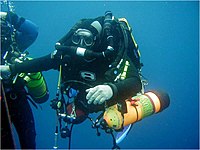
Photo from wikipedia
Nitrification is a vital ecosystem function in the open ocean that regenerates inorganic nitrogen and promotes primary production. Recent studies have shown that the ecology and physiology of nitrifying organisms… Click to show full abstract
Nitrification is a vital ecosystem function in the open ocean that regenerates inorganic nitrogen and promotes primary production. Recent studies have shown that the ecology and physiology of nitrifying organisms is more complex than previously postulated. The distribution of these organisms in the remote oligotrophic ocean and their interactions with the physicochemical environment are relatively understudied. In this work, we aimed to evaluate the depth profile of nitrifying archaea and bacteria in the Eastern North Pacific Subtropical Front, an area with limited biological surveys but with intense trophic transferences and physicochemical gradients. Furthermore, we investigated the dominant physicochemical and biological relationships within and between ammonia-oxidizing archaea (AOA), ammonia-oxidizing bacteria (AOB), and nitrite-oxidizing bacteria (NOB) as well as with the overall prokaryotic community. We used a 16S rRNA gene sequencing approach to identify and characterize the nitrifying groups within the first 500 m of the water column and to analyze their abiotic and biotic interactions. The water column was characterized mainly by two contrasting environments, warm O2-rich surface waters with low dissolved inorganic nitrogen (DIN) and a cold O2-deficient mesopelagic layer with high concentrations of nitrate (NO3–). Thaumarcheotal AOA and bacterial NOB were highly abundant below the deep chlorophyll maximum (DCM) and in the mesopelagic. In the mesopelagic, AOA and NOB represented up to 25 and 3% of the total prokaryotic community, respectively. Interestingly, the AOA community in the mesopelagic was dominated by unclassified genera that may constitute a novel group of AOA highly adapted to the conditions observed at those depths. Several of these unclassified amplicon sequence variants (ASVs) were positively correlated with NO3– concentrations and negatively correlated with temperature and O2, whereas known thaumarcheotal genera exhibited the opposite behavior. Additionally, we found a large network of positive interactions within and between putative nitrifying ASVs and other prokaryotic groups, including 13230 significant correlations and 23 sub-communities of AOA, AOB, NOB, irrespective of their taxonomic classification. This study provides new insights into our understanding of the roles that AOA may play in recycling inorganic nitrogen in the oligotrophic ocean, with potential consequences to primary production in these remote ecosystems.
Journal Title: Frontiers in Microbiology
Year Published: 2021
Link to full text (if available)
Share on Social Media: Sign Up to like & get
recommendations!